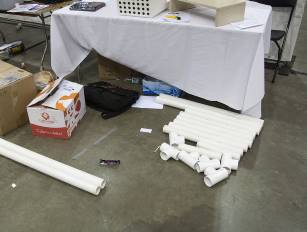Whether you’re rebuilding or remodeling, your trash can is likely to be bursting at the seams throughout the process. But should it be? Here are some home materials that should definitely stay out of the trash.
Copper Pipes and Wires
Copper is an essential component in electrical items, from the latest smartphones to the most mundane power plugs. The copper wires and pipes within your home’s walls ought to be recycled to keep this precious metal in ready and cheap supply. Recycling copper is said to require only about 10 percent of the energy required to mine it. And it’s also much cheaper to recycle this material as well, because the petroleum and other fuels necessary for copper extraction operations can be expensive and in unstable supply.
Concrete
Dry concrete mixtures are composed of portland cement and aggregates, the latter of which can range in size from 0.375 to 1.5 inches. Stone, sand and crushed concrete are common aggregates in new, dry concrete mixtures. That means if you are removing a concrete sidewalk, patio, driveway or foundation, the chunks of old concrete can be hauled to a processing plant to be ground into finer particles, suitable for reuse as aggregates.

PVC pipe. Image credit: Digital Game Museum (Source: Flickr)
The best concrete aggregates are “clean,” meaning they are not coated with chemicals or other substances that could compromise the durability of the new concrete installation. Another example of concrete recycling is called rubblization: if concrete roads will be replaced with asphalt, the concrete can be broken into gravel-sized chunks on-site in order to serve as a foundation for the asphalt, removing the need to haul the concrete away and to replace it with new materials.
PVC Pipes
As a plastic, PVC sometimes gets a bad rap for being unsustainable, but such characterization couldn’t be further from the truth. PVC is easily recycled and can be turned into new products. In fact, there are multiple ways in which PVC can be recycled, mechanical and chemical being the two main methods of breaking down the material. There are no waste products left over from recycling the PVC itself, and that fact alone makes it an excellent candidate for recycling.
Wood Scraps
Wood is the quintessential recyclable material. It can be processed into a pulp and pressed into products like refabricated wood floor boards, composite wood for various building projects and, of course, paper. Even small scraps of wood should be recycled or reused. It takes years to for a tree to grow large enough to provide large quantities of high-quality wood, especially specialty wood, like large unjointed timbers. It doesn’t make sense to cut down mature trees for mundane products like paper when these items can be made from recycled scraps.
Glass
If you’re already in the habit of recycling glass jars and containers alongside your plastic milk jugs, aluminum cans and cardboard boxes, it should come as no surprise that window panes can and should be recycled too. In fact, glass is 100 percent recyclable, meaning no material is lost during the recycling process, which results in no impurities and allows recycled glass to be used in as many applications as new glass.
“Recycling” Gently Used Items During Remodeling
Doors, windows, light fixtures, wood, PVC or copper pipes, gutters and even appliances can all be reused instead of recycled. Habitat for Humanity, for example, operates numerous construction overstock supply stores. If you are remodeling your home and have any features that are still in great shape, drop them off at such a store, or call local contractors to find out the local junkyard alternative.
*Author’s Bio: Cathy Habas is a full-time freelance writer based in Louisville. Her areas of expertise run the gamut, from home improvement to health to equestrian sports. She can be reached via her website, cathyhabas.com.
